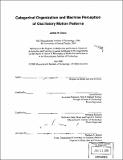Categorical organization and machine perception of oscillatory motion patterns
Author(s)
Davis, James William, 1968-
DownloadFull printable version (11.83Mb)
Other Contributors
Massachusetts Institute of Technology. Dept. of Architecture.
Advisor
Aaron Bobick and Whitman Richards.
Terms of use
Metadata
Show full item recordAbstract
Many animal behaviors consist of using special patterns of motion for communication, with certain types of movements appearing widely across animal species. Oscillatory motions in particular are quite prevalent, where many of these repetitive movements can be characterized by a simple sinusoidal model with very specific and limited parameter values. We develop a computational model of categorical perception of these motion patterns based on their inherent structural regularity. The model proposes the initial construction of a hierarchical ordering of the model parameters to partition them into sub-categorical specializations. This organization is then used to specify the types and layout of localized computations required for the corresponding visual recognition system. The goal here is to do away with ad hoc motion recognition methods of computer vision, and instead exploit the underlying structural description for a motion category as a motivating mechanism for recognition. We implement this framework and present an analysis of the approach with synthetic and real oscillatory motions, and demonstrate its applicability within an interactive artificial life environment. With this categorical foundation for the description and recognition of related motions, we gain insight into the basis and development of a machine vision system designed to recognize these patterns.
Description
Thesis (Ph.D.)--Massachusetts Institute of Technology, Dept. of Architecture, 2000. Includes bibliographical references (p. 126-132).
Date issued
2000Department
Massachusetts Institute of Technology. Department of ArchitecturePublisher
Massachusetts Institute of Technology
Keywords
Architecture.